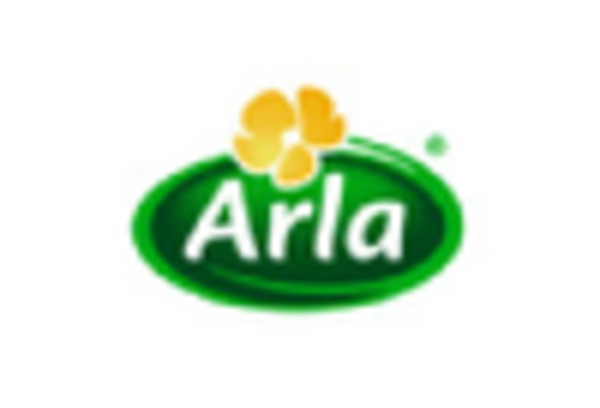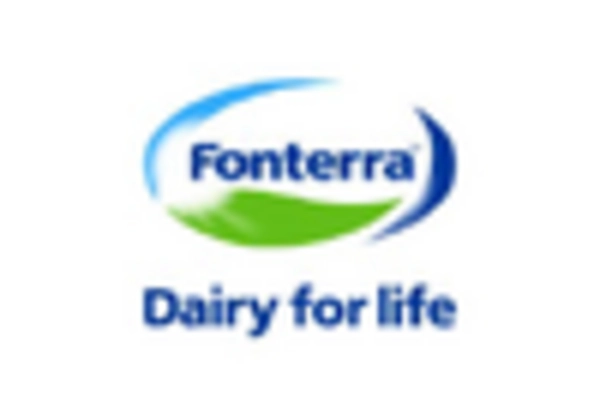Cheddar
Mozzarella
Cream Cheese
Ricotta
Block
Sliced
Grated
Spreadable
Cow Milk
Goat Milk
Sheep Milk
Plant-Based
Food Industry
Food Service
Household
North America
Europe
South America
Asia Pacific
Middle East and Africa
North America Outlook (USD Billion, 2019-2035)
North America Cheese Market by Type
Cheddar
Mozzarella
Cream Cheese
Ricotta
North America Cheese Market by Form Type
Block
Sliced
Grated
Spreadable
North America Cheese Market by Source Type
Cow Milk
Goat Milk
Sheep Milk
Plant-Based
North America Cheese Market by Application Type
Food Industry
Food Service
Household
North America Cheese Market by Regional Type
US
Canada
US Outlook (USD Billion, 2019-2035)
US Cheese Market by Type
Cheddar
Mozzarella
Cream Cheese
Ricotta
US Cheese Market by Form Type
Block
Sliced
Grated
Spreadable
US Cheese Market by Source Type
Cow Milk
Goat Milk
Sheep Milk
Plant-Based
US Cheese Market by Application Type
Food Industry
Food Service
Household
CANADA Outlook (USD Billion, 2019-2035)
CANADA Cheese Market by Type
Cheddar
Mozzarella
Cream Cheese
Ricotta
CANADA Cheese Market by Form Type
Block
Sliced
Grated
Spreadable
CANADA Cheese Market by Source Type
Cow Milk
Goat Milk
Sheep Milk
Plant-Based
CANADA Cheese Market by Application Type
Food Industry
Food Service
Household
Europe Outlook (USD Billion, 2019-2035)
Europe Cheese Market by Type
Cheddar
Mozzarella
Cream Cheese
Ricotta
Europe Cheese Market by Form Type
Block
Sliced
Grated
Spreadable
Europe Cheese Market by Source Type
Cow Milk
Goat Milk
Sheep Milk
Plant-Based
Europe Cheese Market by Application Type
Food Industry
Food Service
Household
Europe Cheese Market by Regional Type
Germany
UK
France
Russia
Italy
Spain
Rest of Europe
GERMANY Outlook (USD Billion, 2019-2035)
GERMANY Cheese Market by Type
Cheddar
Mozzarella
Cream Cheese
Ricotta
GERMANY Cheese Market by Form Type
Block
Sliced
Grated
Spreadable
GERMANY Cheese Market by Source Type
Cow Milk
Goat Milk
Sheep Milk
Plant-Based
GERMANY Cheese Market by Application Type
Food Industry
Food Service
Household
UK Outlook (USD Billion, 2019-2035)
UK Cheese Market by Type
Cheddar
Mozzarella
Cream Cheese
Ricotta
UK Cheese Market by Form Type
Block
Sliced
Grated
Spreadable
UK Cheese Market by Source Type
Cow Milk
Goat Milk
Sheep Milk
Plant-Based
UK Cheese Market by Application Type
Food Industry
Food Service
Household
FRANCE Outlook (USD Billion, 2019-2035)
FRANCE Cheese Market by Type
Cheddar
Mozzarella
Cream Cheese
Ricotta
FRANCE Cheese Market by Form Type
Block
Sliced
Grated
Spreadable
FRANCE Cheese Market by Source Type
Cow Milk
Goat Milk
Sheep Milk
Plant-Based
FRANCE Cheese Market by Application Type
Food Industry
Food Service
Household
RUSSIA Outlook (USD Billion, 2019-2035)
RUSSIA Cheese Market by Type
Cheddar
Mozzarella
Cream Cheese
Ricotta
RUSSIA Cheese Market by Form Type
Block
Sliced
Grated
Spreadable
RUSSIA Cheese Market by Source Type
Cow Milk
Goat Milk
Sheep Milk
Plant-Based
RUSSIA Cheese Market by Application Type
Food Industry
Food Service
Household
ITALY Outlook (USD Billion, 2019-2035)
ITALY Cheese Market by Type
Cheddar
Mozzarella
Cream Cheese
Ricotta
ITALY Cheese Market by Form Type
Block
Sliced
Grated
Spreadable
ITALY Cheese Market by Source Type
Cow Milk
Goat Milk
Sheep Milk
Plant-Based
ITALY Cheese Market by Application Type
Food Industry
Food Service
Household
SPAIN Outlook (USD Billion, 2019-2035)
SPAIN Cheese Market by Type
Cheddar
Mozzarella
Cream Cheese
Ricotta
SPAIN Cheese Market by Form Type
Block
Sliced
Grated
Spreadable
SPAIN Cheese Market by Source Type
Cow Milk
Goat Milk
Sheep Milk
Plant-Based
SPAIN Cheese Market by Application Type
Food Industry
Food Service
Household
REST OF EUROPE Outlook (USD Billion, 2019-2035)
REST OF EUROPE Cheese Market by Type
Cheddar
Mozzarella
Cream Cheese
Ricotta
REST OF EUROPE Cheese Market by Form Type
Block
Sliced
Grated
Spreadable
REST OF EUROPE Cheese Market by Source Type
Cow Milk
Goat Milk
Sheep Milk
Plant-Based
REST OF EUROPE Cheese Market by Application Type
Food Industry
Food Service
Household
APAC Outlook (USD Billion, 2019-2035)
APAC Cheese Market by Type
Cheddar
Mozzarella
Cream Cheese
Ricotta
APAC Cheese Market by Form Type
Block
Sliced
Grated
Spreadable
APAC Cheese Market by Source Type
Cow Milk
Goat Milk
Sheep Milk
Plant-Based
APAC Cheese Market by Application Type
Food Industry
Food Service
Household
APAC Cheese Market by Regional Type
China
India
Japan
South Korea
Malaysia
Thailand
Indonesia
Rest of APAC
CHINA Outlook (USD Billion, 2019-2035)
CHINA Cheese Market by Type
Cheddar
Mozzarella
Cream Cheese
Ricotta
CHINA Cheese Market by Form Type
Block
Sliced
Grated
Spreadable
CHINA Cheese Market by Source Type
Cow Milk
Goat Milk
Sheep Milk
Plant-Based
CHINA Cheese Market by Application Type
Food Industry
Food Service
Household
INDIA Outlook (USD Billion, 2019-2035)
INDIA Cheese Market by Type
Cheddar
Mozzarella
Cream Cheese
Ricotta
INDIA Cheese Market by Form Type
Block
Sliced
Grated
Spreadable
INDIA Cheese Market by Source Type
Cow Milk
Goat Milk
Sheep Milk
Plant-Based
INDIA Cheese Market by Application Type
Food Industry
Food Service
Household
JAPAN Outlook (USD Billion, 2019-2035)
JAPAN Cheese Market by Type
Cheddar
Mozzarella
Cream Cheese
Ricotta
JAPAN Cheese Market by Form Type
Block
Sliced
Grated
Spreadable
JAPAN Cheese Market by Source Type
Cow Milk
Goat Milk
Sheep Milk
Plant-Based
JAPAN Cheese Market by Application Type
Food Industry
Food Service
Household
SOUTH KOREA Outlook (USD Billion, 2019-2035)
SOUTH KOREA Cheese Market by Type
Cheddar
Mozzarella
Cream Cheese
Ricotta
SOUTH KOREA Cheese Market by Form Type
Block
Sliced
Grated
Spreadable
SOUTH KOREA Cheese Market by Source Type
Cow Milk
Goat Milk
Sheep Milk
Plant-Based
SOUTH KOREA Cheese Market by Application Type
Food Industry
Food Service
Household
MALAYSIA Outlook (USD Billion, 2019-2035)
MALAYSIA Cheese Market by Type
Cheddar
Mozzarella
Cream Cheese
Ricotta
MALAYSIA Cheese Market by Form Type
Block
Sliced
Grated
Spreadable
MALAYSIA Cheese Market by Source Type
Cow Milk
Goat Milk
Sheep Milk
Plant-Based
MALAYSIA Cheese Market by Application Type
Food Industry
Food Service
Household
THAILAND Outlook (USD Billion, 2019-2035)
THAILAND Cheese Market by Type
Cheddar
Mozzarella
Cream Cheese
Ricotta
THAILAND Cheese Market by Form Type
Block
Sliced
Grated
Spreadable
THAILAND Cheese Market by Source Type
Cow Milk
Goat Milk
Sheep Milk
Plant-Based
THAILAND Cheese Market by Application Type
Food Industry
Food Service
Household
INDONESIA Outlook (USD Billion, 2019-2035)
INDONESIA Cheese Market by Type
Cheddar
Mozzarella
Cream Cheese
Ricotta
INDONESIA Cheese Market by Form Type
Block
Sliced
Grated
Spreadable
INDONESIA Cheese Market by Source Type
Cow Milk
Goat Milk
Sheep Milk
Plant-Based
INDONESIA Cheese Market by Application Type
Food Industry
Food Service
Household
REST OF APAC Outlook (USD Billion, 2019-2035)
REST OF APAC Cheese Market by Type
Cheddar
Mozzarella
Cream Cheese
Ricotta
REST OF APAC Cheese Market by Form Type
Block
Sliced
Grated
Spreadable
REST OF APAC Cheese Market by Source Type
Cow Milk
Goat Milk
Sheep Milk
Plant-Based
REST OF APAC Cheese Market by Application Type
Food Industry
Food Service
Household
South America Outlook (USD Billion, 2019-2035)
South America Cheese Market by Type
Cheddar
Mozzarella
Cream Cheese
Ricotta
South America Cheese Market by Form Type
Block
Sliced
Grated
Spreadable
South America Cheese Market by Source Type
Cow Milk
Goat Milk
Sheep Milk
Plant-Based
South America Cheese Market by Application Type
Food Industry
Food Service
Household
South America Cheese Market by Regional Type
Brazil
Mexico
Argentina
Rest of South America
BRAZIL Outlook (USD Billion, 2019-2035)
BRAZIL Cheese Market by Type
Cheddar
Mozzarella
Cream Cheese
Ricotta
BRAZIL Cheese Market by Form Type
Block
Sliced
Grated
Spreadable
BRAZIL Cheese Market by Source Type
Cow Milk
Goat Milk
Sheep Milk
Plant-Based
BRAZIL Cheese Market by Application Type
Food Industry
Food Service
Household
MEXICO Outlook (USD Billion, 2019-2035)
MEXICO Cheese Market by Type
Cheddar
Mozzarella
Cream Cheese
Ricotta
MEXICO Cheese Market by Form Type
Block
Sliced
Grated
Spreadable
MEXICO Cheese Market by Source Type
Cow Milk
Goat Milk
Sheep Milk
Plant-Based
MEXICO Cheese Market by Application Type
Food Industry
Food Service
Household
ARGENTINA Outlook (USD Billion, 2019-2035)
ARGENTINA Cheese Market by Type
Cheddar
Mozzarella
Cream Cheese
Ricotta
ARGENTINA Cheese Market by Form Type
Block
Sliced
Grated
Spreadable
ARGENTINA Cheese Market by Source Type
Cow Milk
Goat Milk
Sheep Milk
Plant-Based
ARGENTINA Cheese Market by Application Type
Food Industry
Food Service
Household
REST OF SOUTH AMERICA Outlook (USD Billion, 2019-2035)
REST OF SOUTH AMERICA Cheese Market by Type
Cheddar
Mozzarella
Cream Cheese
Ricotta
REST OF SOUTH AMERICA Cheese Market by Form Type
Block
Sliced
Grated
Spreadable
REST OF SOUTH AMERICA Cheese Market by Source Type
Cow Milk
Goat Milk
Sheep Milk
Plant-Based
REST OF SOUTH AMERICA Cheese Market by Application Type
Food Industry
Food Service
Household
MEA Outlook (USD Billion, 2019-2035)
MEA Cheese Market by Type
Cheddar
Mozzarella
Cream Cheese
Ricotta
MEA Cheese Market by Form Type
Block
Sliced
Grated
Spreadable
MEA Cheese Market by Source Type
Cow Milk
Goat Milk
Sheep Milk
Plant-Based
MEA Cheese Market by Application Type
Food Industry
Food Service
Household
MEA Cheese Market by Regional Type
GCC Countries
South Africa
Rest of MEA
GCC COUNTRIES Outlook (USD Billion, 2019-2035)
GCC COUNTRIES Cheese Market by Type
Cheddar
Mozzarella
Cream Cheese
Ricotta
GCC COUNTRIES Cheese Market by Form Type
Block
Sliced
Grated
Spreadable
GCC COUNTRIES Cheese Market by Source Type
Cow Milk
Goat Milk
Sheep Milk
Plant-Based
GCC COUNTRIES Cheese Market by Application Type
Food Industry
Food Service
Household
SOUTH AFRICA Outlook (USD Billion, 2019-2035)
SOUTH AFRICA Cheese Market by Type
Cheddar
Mozzarella
Cream Cheese
Ricotta
SOUTH AFRICA Cheese Market by Form Type
Block
Sliced
Grated
Spreadable
SOUTH AFRICA Cheese Market by Source Type
Cow Milk
Goat Milk
Sheep Milk
Plant-Based
SOUTH AFRICA Cheese Market by Application Type
Food Industry
Food Service
Household
REST OF MEA Outlook (USD Billion, 2019-2035)
REST OF MEA Cheese Market by Type
Cheddar
Mozzarella
Cream Cheese
Ricotta
REST OF MEA Cheese Market by Form Type
Block
Sliced
Grated
Spreadable
REST OF MEA Cheese Market by Source Type
Cow Milk
Goat Milk
Sheep Milk
Plant-Based
REST OF MEA Cheese Market by Application Type
Food Industry
Food Service
Household

















Leave a Comment